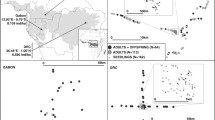Abstract
We surveyed four populations of contrasting size (two isolated and two large stands) of a woody outcrossing species, Discaria trinervis (Rhamnaceae), which has a naturally dissected distribution. Our main goal was to investigate the floral biology, breeding system and pollination mechanism of the species, which in turn may help to explain the mechanisms underlying the survival of the isolated populations. Discaria trinervis is both wind- and insect-pollinated, showing interactions with a large fraction of the available flower visitors at both stand sizes. In the larger populations, stigmatic loads were larger, more pollen tubes reached the ovules, and fruit and seed set were higher; however, the reproductive output in the smaller populations (over 2000 seeds per plant per year) seemed adequate for population persistence. Human disturbance (e.g. destruction of trees for wood extraction) may put these smaller populations at risk through loss of incompatibility alleles. The results suggest that plant species with naturally dissected distributions may provide clues about which reproductive mechanisms ensure survival under fragmentation.
Similar content being viewed by others
Author information
Authors and Affiliations
Corresponding author
Rights and permissions
About this article
Cite this article
Medan, D., Devoto, M. Reproductive ecology of a perennial outcrosser with a naturally dissected distribution. Plant Syst. Evol. 254, 173–184 (2005). https://doi.org/10.1007/s00606-005-0335-3
Received:
Accepted:
Published:
Issue Date:
DOI: https://doi.org/10.1007/s00606-005-0335-3




